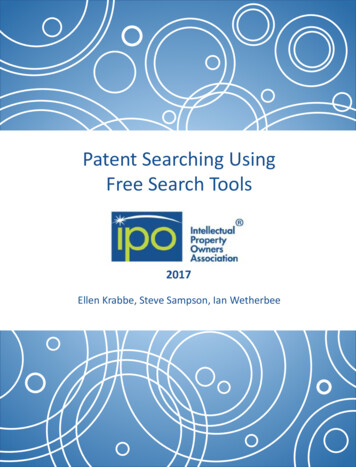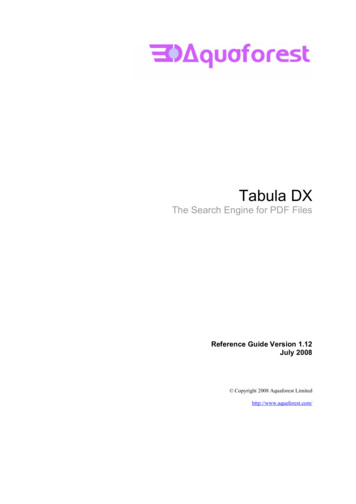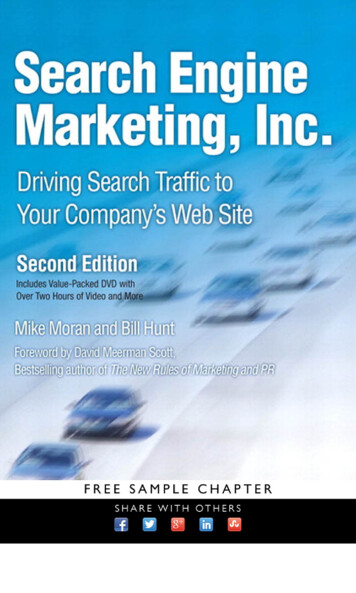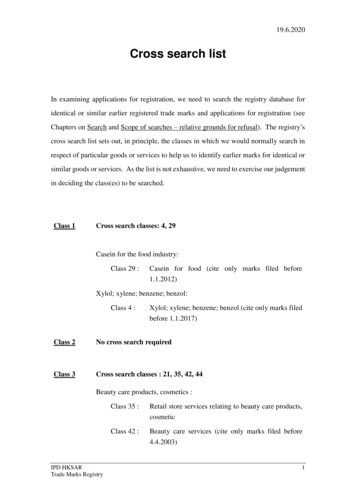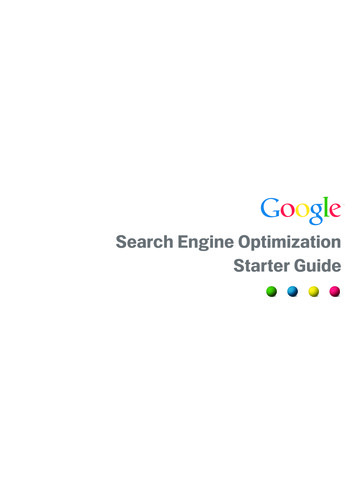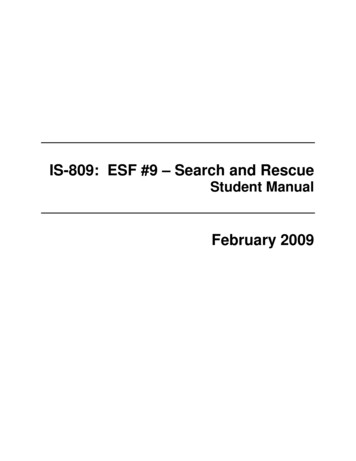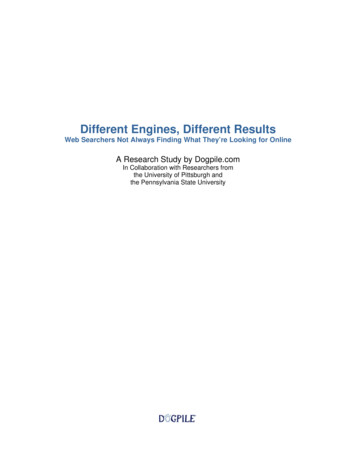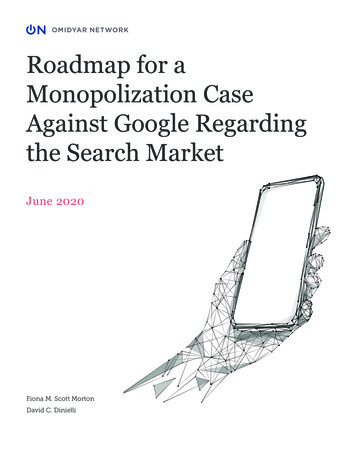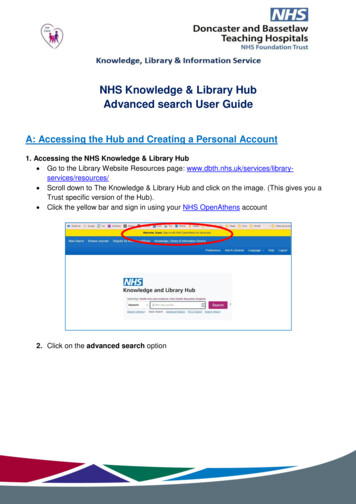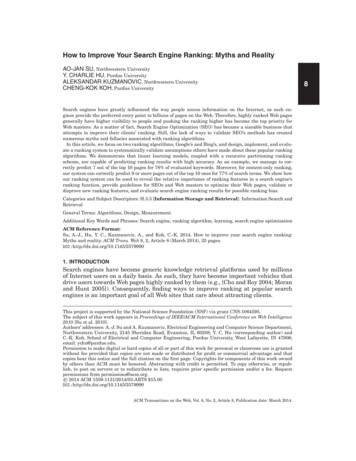
Transcription
iiiiHow to Improve Your Search Engine Ranking: Myths and RealityAO-JAN SU, Northwestern UniversityY. CHARLIE HU, Purdue UniversityALEKSANDAR KUZMANOVIC, Northwestern UniversityCHENG-KOK KOH, Purdue University8Search engines have greatly influenced the way people access information on the Internet, as such engines provide the preferred entry point to billions of pages on the Web. Therefore, highly ranked Web pagesgenerally have higher visibility to people and pushing the ranking higher has become the top priority forWeb masters. As a matter of fact, Search Engine Optimization (SEO) has became a sizeable business thatattempts to improve their clients’ ranking. Still, the lack of ways to validate SEO’s methods has creatednumerous myths and fallacies associated with ranking algorithms.In this article, we focus on two ranking algorithms, Google’s and Bing’s, and design, implement, and evaluate a ranking system to systematically validate assumptions others have made about these popular rankingalgorithms. We demonstrate that linear learning models, coupled with a recursive partitioning rankingscheme, are capable of predicting ranking results with high accuracy. As an example, we manage to correctly predict 7 out of the top 10 pages for 78% of evaluated keywords. Moreover, for content-only ranking,our system can correctly predict 9 or more pages out of the top 10 ones for 77% of search terms. We show howour ranking system can be used to reveal the relative importance of ranking features in a search engine’sranking function, provide guidelines for SEOs and Web masters to optimize their Web pages, validate ordisprove new ranking features, and evaluate search engine ranking results for possible ranking bias.Categories and Subject Descriptors: H.3.3 [Information Storage and Retrieval]: Information Search andRetrievalGeneral Terms: Algorithms, Design, MeasurementAdditional Key Words and Phrases: Search engine, ranking algorithm, learning, search engine optimizationACM Reference Format:Su, A.-J., Hu, Y. C., Kuzmanovic, A., and Koh, C.-K. 2014. How to improve your search engine ranking:Myths and reality. ACM Trans. Web 8, 2, Article 8 (March 2014), 25 pages.DOI:http://dx.doi.org/10.1145/25799901. INTRODUCTIONSearch engines have become generic knowledge retrieval platforms used by millionsof Internet users on a daily basis. As such, they have become important vehicles thatdrive users towards Web pages highly ranked by them (e.g., [Cho and Roy 2004; Moranand Hunt 2005]). Consequently, finding ways to improve ranking at popular searchengines is an important goal of all Web sites that care about attracting clients.This project is supported by the National Science Foundation (NSF) via grant CNS-1064595.The subject of this work appears in Proceedings of IEEE/ACM International Conference on Web Intelligence2010 [Su et al. 2010].Authors’ addresses: A.-J. Su and A. Kuzmanovic, Electrical Engineering and Computer Science Department,Northwestern University, 2145 Sheridan Road, Evanston, IL 60208; Y. C. Hu (corresponding author) andC.-K. Koh, School of Electrical and Computer Engineering, Purdue University, West Lafayette, IN 47906;email: ychu@purdue.edu.Permission to make digital or hard copies of all or part of this work for personal or classroom use is grantedwithout fee provided that copies are not made or distributed for profit or commercial advantage and thatcopies bear this notice and the full citation on the first page. Copyrights for components of this work ownedby others than ACM must be honored. Abstracting with credit is permitted. To copy otherwise, or republish, to post on servers or to redistribute to lists, requires prior specific permission and/or a fee. Requestpermissions from permissions@acm.org.c 2014 ACM 1559-1131/2014/03-ART8 15.00 DOI:http://dx.doi.org/10.1145/2579990ACM Transactions on the Web, Vol. 8, No. 2, Article 8, Publication date: March 2014.iiii
iiii8:2A.-J. Su et al.Ways to improve a Web page’s search engine ranking are different. On one side,SPAM farms are a well-known approach to attempt to boost a Web site’s ranking. Thisis achieved by artificially inflating a site’s popularity, that is, by increasing the numberof nepotistic links [Davison 2000] pointing to it. Luckily, ways to detect and containsuch approaches appear to be quite successful [Benczúr et al. 2005; Gyongyi et al.2006; Wu and Davison 2005]. On the other side, the entire industry of Search EngineOptimization (SEO) is booming. Such companies (e.g., [TOPSEOs 2014; SeoPros 2014])and experts claim to be capable of improving a Web page’s rank by understandingwhich page design choices and factors are valued by the ranking algorithms.Unfortunately, the lack of any knowledge or independent validation of the SEOmethodologies, and the ever-lasting interest on this topic, has opened the doors tovarious theories and claims, myths and folklore about which particular factor is influential, such as Aubuchon [2010], SEOmoz [2007], Kontopoulos [2007], Patel [2006], Li[2008], AccuraCast [2007], and Marshall [2009]. To the best of our knowledge, noneof these claims is backed by any published scientific evidence. At the same time, theproblem of predicting a search engine’s overall ranking results is widely considereda close-to-impossible task due to its inherent complexity. It should also be noted thatthis article presents an academic, not a commercial study. Thus we have no preferencefor, or bias towards, any commercial search engine.The key contribution of our article is that we demonstrate that simple linear learning models, accompanied by a recursive partitioning ranking scheme, are capable ofpredicting a search engine’s ranking results with high accuracy. As an example, inGoogle’s case, we show that when non-page-content factors are isolated our rankingsystem manages to correctly predict 8 pages within the top 10 for 92% of a set of randomly selected 60 keywords. In the more general scenarios, we manage to correctlypredict 7 or more pages within the top 10 for 78% of the set of keywords searched.In this work, we start by describing several initial unsuccessful attempts at predicting a search engine’s ranking results, to illustrate that reproducing such rankingresults is not a straightforward task. In our initial attempts, we set up cloned andartificial Web sites trying to decouple ranking factors in a search engine’s ranking algorithm. These attempts failed because we could not obtain sufficient data points dueto limited pages being indexed and infrequent visits of a search engine bot.We then revised our approach to consider multiple ranking factors together. We developed an automated ranking system that directly queries a search engine, collectssearch results, and feeds the results to its ranking engine for learning. Our rankingengine incorporates several learning algorithms, based on training both linear andpolynomial models. Using our ranking system, we show that a linear model trainedwith linear programming and accompanied with a recursive partitioning algorithm isable to closely approximate a search engine’s ranking algorithm. In addition, we useour ranking system to analyze the importance of different ranking features to provideguidelines for SEOs and Web masters to improve a search engine’s ranking of Webpages. Furthermore, we present case studies on how our ranking system can facilitatein validating and disproving potential new ranking features reported in the Internet.More specifically, we confirm that the particular search engine (Google) imposes negative bias toward blogs, and that HTML syntax errors have little to no impact on thesearch engine’s ranking.To study the potentially different ranking algorithms used in different search engines, we also use our ranking system to analyze the ranking results of the Bingsearch engine. Our experimental results show that the recursive partitioning algorithm is also beneficial for improving the ranking system’s prediction accuracy forBing. In addition, we compare the relative importance of ranking features of the twosearch engines’ ranking algorithms and show the disagreements between the two.ACM Transactions on the Web, Vol. 8, No. 2, Article 8, Publication date: March 2014.iiii
iiiiHow to Improve Your Search Engine Ranking: Myths and Reality8:3In particular, our case studies for Bing show that the search engine favors incoming links’ quality over quantity and Bing shows no bias toward the overall traffic of aWeb site.In addition to the study we presented in Su et al. [2010], this article adds the following new contributions: in Section 2.3, we describe our unsuccessful initial attemptsin learning a search engine’s ranking system. We expect that our lessons learned willbe valuable for others who will attempt to explore similar problems. In Section 6, wepresent results for using our ranking system to analyze the Bing search engine andcompare them with our findings in Su et al. [2010]. Furthermore, we provide insightsinto the ranking algorithm of the Bing search engine and present new case studies forBing. Thus, while in this work we necessarily limit our analysis to two search engines,namely Google and Bing, our approach is far more generic than reverse engineeringthe two search engines.The rest of the article is structured as follows. In Section 2, we define the problemand outline the folklore around a search engine’s ranking system. In Section 3, wepresent the detailed design of our ranking system. We present the evaluation resultsof using our ranking system to analyze the Google search engine in Section 4 and several case studies in Section 5. We present the evaluation results of using our rankingsystem to analyze the Bing search engine and associated case studies in Section 6. Wediscuss related issues in Section 7. Finally, we conclude in Section 8.2. PROBLEM STATEMENT2.1. GoalsThere have been numerous efforts that attempt to reveal the importance of rankingfactors to a search engine [Aubuchon 2010; Kontopoulos 2007; Patel 2006; SEOmoz2007]. While some of them are guess-works by Web masters [Kontopoulos 2007; Patel2006], others are based on experience of Search Engine Optimization (SEO) experts[Aubuchon 2010; SEOmoz 2007]. While we recognize that guessing and experiencemight indeed be vehicles for revealing search engine internals, we strive for more systematic and scientific avenues to achieve this task. The goal of our study is to understand the important factors that affect the ranking of a Web page as viewed by popularsearch engines. In doing so, we validate some folklore and popular beliefs advertisedby Web masters and the SEO industry.2.1.1. Ranking Features. In this work, we aim to study the relative importance of Webpage features that potentially affect the ranking of a Web page, as listed in Table I.For each Web page (URL), we collect 17 ranking features. These ranking features canfurther be divided into 7 groups. The page group represents characteristics associatedwith the Web page, including Google’s Page Rank score (PR) and the age of the Webpage in a search engine’s index (AGE). The URL group represents features associatedwith the URL of the Web page. Parameter HOST counts the number of occurrences ofthe keyword that appear in the hostname and PATH counts the number of occurrencesof the keyword in the page segment of the URL.The domain group consists of features related to the domain of a Web site. D SIZEreports the number of Web pages indexed by Google in the domain and D AGE reportsthe age of the first page index by archive.org in the domain. Groups header, body,heading, and link are features extracted from the content of the Web page. TITLEcounts the number of occurrences of the keyword in the title tag. M KEY counts thenumber of occurrences of the keyword in the metakeyword tag and M DES countsthe number of occurrences of the keyword in the meta-description tag. DENS is thekeyword density of a Web page, which is calculated as the number of occurrences ofthe keyword divided by the number of words in the Web page. H1 through H5 is theACM Transactions on the Web, Vol. 8, No. 2, Article 8, Publication date: March 2014.iiii
iiii8:4A.-J. Su et al.Table I. Ranking turePRAGEHOSTPATHD SIZED AGETITLEM KEYM DESDENSH1H2H3H4H5ANCHIMGDetailpagerank scoreage of the web page in a search engine’s indexkeyword appear in hostnamekeyword in the path segment of urlsize of the web site’s domainage of the web site’s domainkeyword in the title tag of HTML headerkeyword in meta-keyword tagkeyword in meta-description tagkeyword densitykeyword in h1 tagkeyword in h2 tagkeyword in h3 tagkeyword in h4 tagkeyword in h5 tagkeyword in anchor textkeyword in image tagnumber of occurrences of the keyword in all the headings H1 to H5, respectively. ANCHcounts the number of occurrences of the keyword in the anchor text of an outgoing linkand IMG counts the number of occurrences of the keyword in an image tag.Google claims to use more than 200 parameters in its ranking system. Necessarily,we explore only a subset of all possible features. Still, we demonstrate that rankingfeatures listed in Table I are adequate for providing high ranking prediction accuracy.Moreover, we are capable of establishing important relationships among the exploredfeatures.2.2. State-of-the-Affairs (the Folklore)The great popularity and the impact that search engines have in shaping users’ browsing behavior have created significant interests and attempts to understand how theirranking algorithms work. Still, there is no consensus on the set of the most importantfeatures. Different people express quite different opinions, as we illustrate shortly.To get a glimpse of how little agreement there is about the relative importance ofranking features, we collect different opinions for a seach engine’s ranking featuresand summarize in Table II. We acknowledge this is not a comprehensive survey; ratherit is a collection of anecdotal evidence from several diverse sources. In particular, thesecond column labeled by SEOmoz’07 [SEOmoz 2007] is a list of top 10 ranking factors created by surveying 37 SEO experts by SEOmoz.org in 2007. This column represents observations from knowledgeable experts. The third column labeled by Survey[Kontopoulos 2007] is a list of top 10 ranking features rated by a poll of Internet usersinterested in this topic. This column represents the perception of the search engines’ranking algorithm from general Internet users. While the Internet users may not bepage ranking experts, they are the ultimate end-users who tune their Web pages according to their beliefs and thus who are affected the most. Finally, the fourth columnlabeled as Idv [Marshall 2009] is the top 10 ranking feature list posted by an Internet marketing expert on his personal Web page. This column represents an individualinvestigator that studies this topic. We note the SEOmoz and Survey opinions are forsearch ranking in general, and the LDV opinion is about Google search.Due to the lack of systematic measuring and evaluating guidelines, it is not surprising to see significant differences in ranking between the three lists. The SEO expertsACM Transactions on the Web, Vol. 8, No. 2, Article 8, Publication date: March 2014.iiii
iiiiHow to Improve Your Search Engine Ranking: Myths and Reality8:5Table II. Various Ranking Feature Opinions#12345678910SEOmoz’07Keyword use in title tagAnchor text of inboundlinkGlobal link popularityof siteAge of siteLink popularity withinthe site’s internallink structureTopical relevance ofinbound links to siteLink popularity of sitein topical communityKeyword use in body textGlobal link popularityof linking siteTopical relationship oflinking pageSurveyKeywords in titleIdvKeyword in URLKeywords in domain nameKeyword in domain nameAnchor text of inboundlinksKeywords in heading tagsKeyword in title tagKeyword in H1, H2 and H3Keywords in URLPage RankAnchor text from withinthe siteAnchor text of inbound linkto youSite listed in DMOZDirectorySite listed in YahooDirectoryRank Manipulation byCompetitor AttackInternal linksKeywords in Alt attributeof imagesRelevance of external linksKeywords in bodySite Ageobviously favor ranking features associated with hyperlinks as they rated 7 out of thetop 10 ranking features in this category. On the contrary, the other two opinions haveonly 3 and 1 top 10 ranking features associated with links, respectively. In addition,the Web site’s age feature is in the top 4 features among SEOs, but is absent in thesecond list and is at the bottom of the third list.From time to time, Internet users will see rumors that spread about a search engine’s ranking algorithm. However, to the best of our knowledge, there does not exista systematic approach to validate or disprove these assumptions. This motivates us toperform research in this topic and build a system to facilitate the necessary evaluationprocess.2.3. Initial AttemptsOur path towards achieving the preceding goal was not straightforward. In thissection, we present our initial unsuccessful attempts in approaching this problem. Wehope that the lessons learned here could save time and hence be useful for others whoattempt to explore this problem.Reverse engineering a search engine’s ranking algorithm of its organic search engineresult pages is a difficult task because it is a multi-variable optimization problem in ahighly uncertain environment. Hence, our initial attempts were focused on designingseveral experiments that aim to isolate a subset of ranking features and evaluate theirrelative importance in isolation. We describe these attempts next.2.3.1. Cloned Web Sites. Our first attempt was trying to decouple Web content fromother ranking factors such as page rank score, domain reputation, and page freshness.Our technique involves cloning Web sites from two reputable domains (slashdot.organd coffeegeek.com) to our new established domain. We retain each Web item in theoriginal Web site except hosting the content in our own Web server and change thedomain name in each URL. We submit our new Web sites to Google via its Web-mastertool [Google 2014c]. In addition, we inform Google bot of every Web page in the newWeb sites by generating a sitemap for Google bot to crawl. However, this attempt couldnot live up to our expectations due to the following reason: Google bot crawled andACM Transactions on the Web, Vol. 8, No. 2, Article 8, Publication date: March 2014.iiii
iiii8:6A.-J. Su et al.indexed only a very limited number of pages in our cloned Web site. Our understandingis that the Google bot conserves its resources in this way. In addition, our cloned Website might be detected as a SPAM Web site by Google and thus prevent Google’s crawlerto visit our Web site again. This left us with very few data points to evaluate the searchengine’s content score ranking algorithm.2.3.2. Artificial Web Sites. In another attempt to isolate the impact of the features, weuse our isolated domain and set up artificial Web sites with fabricated Web pages. Ouridea is that even if we cannot make a search engine index a large number of pagesin our Web sites, we can modify the content of the Web pages and still get more datapoints. We carefully design our Web pages to contain different numbers of targetedkeywords and we place these keywords in different HTML tags. Similarly, we submitthese new Web sites to Google and wait for Google bot to visit. Once the Google botcrawls and indexes a Web page, we measure and record the ranking result and changethe content of the indexed page in an attempt to obtain more data points. However,after several weeks of measurements, we still could not get enough data points toanalyze the results. This is because the frequency of Google bot’s visits was very low(once per week) and the number of indexed pages was small (less than 20 per domain).2.3.3. Summary. In our initial attempts, we tried to set up new Web sites (cloned orfabricated) in order to evaluate a search engine’s ranking algorithm by decoupling theranking factors. These attempts failed because the search engine bot indexed very limited number of Web pages for newly established Web sites. In addition, the frequencyof the search engine bot’s visit is also too low, which makes the turn-around time ofcontent change to ranking change very long. In short, it may take a very long time tocollect sufficient data points to evaluate a search engine’s ranking algorithm by thepreceding methods. Nonetheless, we find that our original idea of separating differentranking factors to be quite useful. We demonstrate that it is possible to apply thisapproach using advanced searching querying methods, such as those available in theGoogle API, later in Section 5.1.3. METHODOLOGYIn this section, we discuss the design of our ranking system that analyzes a searchengine’s ranking algorithm.3.1. Design GoalsThere are several design goals that such a ranking system should meet.— The system should be automated. In particular, the data collection (from the Web)and the offline analysis should all be automated.— The system should output human-readable results. In particular, the output of thesystem should give intuitive explanations to why some Web pages are ranked higherthan others, and provide guidelines for how to improve the ranking of Web pages.— The system should be able to handle a large amount of data, as the training set andthe training of the ranking model should converge in a reasonable amount of time.— The ranking system should be extensible. For instance, it should be able to accommodate new ranking features when they are available.— The system should rely only on publicly available information and it should avoidany intrusive operations to the targeted search engine.ACM Transactions on the Web, Vol. 8, No. 2, Article 8, Publication date: March 2014.iiii
iiiiHow to Improve Your Search Engine Ranking: Myths and Reality8:7Fig. 1. System architecture.3.2. A Practical ApproachWe have designed and implemented a ranking system that meets the aforesaid designgoals. The architecture of our system is depicted in Figure 1. The two major components are the crawler and the ranking engine.Our initial unsuccessful attempts (discussed in Section 2.3) suggest that it is difficult and impractical to isolate the impact of individual features that may affect theranking, for example, one at a time. Therefore, we resort to considering the impact ofmultiple features together. This boils down to issuing search queries to a search engine and collecting and analyzing the search results. The data collection is performedby the crawler which queries a search engine and receives the ranked search results.In addition, it downloads HTML Web pages from their original Web sites and queriesdomain information as described in Section 3.3.Second, since multiple features can affect the ranking of Web pages in complicatedways, the ranking engine extracts features under study from raw Web pages and performs learning to train several ranking models to approximate the ranking results bya search engine. In this part, we make several contributions: (1) We confirm that asearch engine’s ranking function is not a simple linear function of all the features, byshowing a nonlinear model can outperform, that is, approximates a search engine’sranking better than, a simple linear model. However, a nonlinear model is difficult forhumans to digest. (2) We present a simple recursive ranking procedure based on a simple linear model and show that it can achieve comparable accuracies to the nonlinearmodel. The theoretical underpinning for such a procedure is that recursive applicationof a linear model (function) can effectively approximate a nonlinear function. In addition, the linear model converges more efficiently and outputs more human-readableresults.3.3. The CrawlerThe crawler submits queries to a search engine and obtains top 100 Web pages (URL)for each keyword. Without losing generality, we limited our queries to HTML files toACM Transactions on the Web, Vol. 8, No. 2, Article 8, Publication date: March 2014.iiii
iiii8:8A.-J. Su et al.avoid Web pages in different file format such as PDFs and DOCs that could createunnecessary complications in our experiments. In addition, we focus on Web pagescomposed in English in our experiments. For example, the Google API syntax we usefor the previous two features is as filetype:html&lr lang en. Moreover, to obtainthe date that a search engine indexed the Web pages, we submit our queries with anadditional parameter qdr:y10. By doing so, the date that a search engine indexed theWeb page will be returned in the search result page for us to extract the age of thepage ranking feature. Finally, for each Web page, the crawler does the following.(1) It downloads the Web page from the original Web site.(2) In case of the Google search engine, it queries the URL’s page rank score by Googletoolbar’s API [Google 2014a].(3) It obtains the age of a page (the latest date a search engine crawled the Web page)by parsing the search result page.(4) It obtains the size (the total number of pages) of the domain by querying a searchengine with site:[domain].(5) It queries archive.org and fetches the age of the Web site (the date when the firstWeb page was created on this Web site).3.4. The Ranking EngineThere are three components in the ranking engine. The HTML parser [PHP HTMLParser 2014] converts Web pages into the Document Object Model (DOM) for the taganalyzer to examine the number of keywords that appear in different HTML tags suchas anchor text. The ranking engine trains the ranking model by combining featuresobtained from the Web page contents, page rank scores, and domain information. After the model is created, the ranking engine evaluates the testing sets by applying themodel. The evaluator then analyzes the results and provides feedback to the rankingengine which is used to adjust parameters in the learning algorithms such as errorthreshold. In the following sections, we describe the two ranking models we experimented in this article: linear programming and SVM. We use ranking features listedin Table I to train our ranking models.3.4.1. Linear Programming Ranking Model. In this section, we describe our linear programming ranking model. Given a set of documents I (i1 , i2 , ., in ), predefined searchengine ranking G (1, 2, ., n), and a ranking algorithm A, the goal is to find a set ofweights W (w1 , w2 , ., wm ) that makes the ranking algorithm reproduce the searchengine ranking with minimum errors. The objective function of the linear programming algorithm attempts to minimize errors (the sum of penalties) of the ranking ofa document set. Eq. (1) defines the objective function which is a pairwise comparisonbetween two documents in a given dataset. (W) nn ci · i j · D(i, j).(1)i 1 j i 1In Eq. (1), ci is a factor that weights the importance of the it h document (e.g., atop 5th page is more important than a top 50th page). i j is the distance (rankingdifference) between the ith and the jth page. Finally, D(i, j) is a decision function wedefine as 0 if f (A, W, i) f (A, W, j),D(i, j) (2)1 if f (A, W, i) f (A, W, j).where f (A, W, i) is the score produced by algorithm A with a set of weights W for the ithpage in the given dataset. Page X is ranked higher than page Y if it receives a higherACM Transactions on the Web, Vol. 8, No. 2, Article 8, Publication date: March 2014.iiii
iiiiHow to Improve Your Search Engine Ranking: Myths and Reality8:9score than page Y. The decision function denotes that if the ranking of the two pagespreserves the order as the search engine’s ranking, the penalty is zero. Otherwise, thepenalty will be counted in the error function which is denoted in Eq. (1).Since we cannot import conditional functions (e.g., D(i, j)) into a linear programmingsolver, we transform the decision function into the following formf (A, W, i) Dij Fmax f (A, W, j),(3)where Fmax is the maximum value to which f (A, W, ·) would evaluate, and Dij {0, 1}.When Dij 0, the preceding inequality is satisfied only iff (A, W, i) f (A, W, j).(4)When Dij 1, the inequality is always satisifed. Therefore, we have effectivelyconverted the original minimization problem into the problem of minimizing the Dij .Hence, we can now replace D(i, j) in the objective function with Dij . Finally, thescore function f (A, W, i) can be represented by a dot-product of ranking parametersX (x1 , x2 , ., xm ) and weights W (w1 , w2 , ., wm ) denoted as f (A, W, i) fA (wi · xi ).For example, the parameter xi can be the number of keywords that occur in the titletag and wi is the weight associated with xi .In addition to the objective function, we set constraints to our linear programmingmodel. For each pair of pages (i, j) where i j (i is ranked higher than j by the searchengine), we have a constraintf (A, W, j) f (A, W, i) τ ,(5)where τ is the maximum allowed error which is set to a predefined constant τ . The constant τ is adjusted by the feedback from the evaluator to refine the ranking results. Forexample, when linear programing solver cannot find a feasible solution, we relax themaximum allowed error τ . The linear programming solver we use in our experimentsis ILOG CPLEX [CPLEX 2014]. In addition, we apply a recursive partitioning algorithmas we describe in Section 3.4.3 shortly.3.4.2. Support Vector Machines’ Ranking Model. Support Vector Machines (SVMs) are aset of supervised learning methods used for classification, regression, and learningranking functions [Vapnik 2000]. In an SVM, data points are viewed as n-dimensionalvectors (n equals to the number of ranking features in our case). An SVM constructsa hyperplane or a set of hyperplanes in a high-dimensional space, which is used as aclassifier to separate data points. In our experiments, we us
of using our ranking system to analyze the Google search engine in Section 4 and sev-eral case studies in Section 5. We present the evaluation results of using our ranking system to analyze the Bing search engine and associated case studies in Section 6. We discuss related issues in Section 7. Finally, we conclude in Section 8. 2. PROBLEM .
